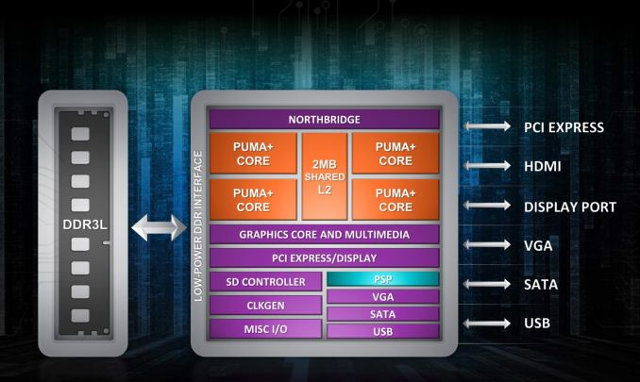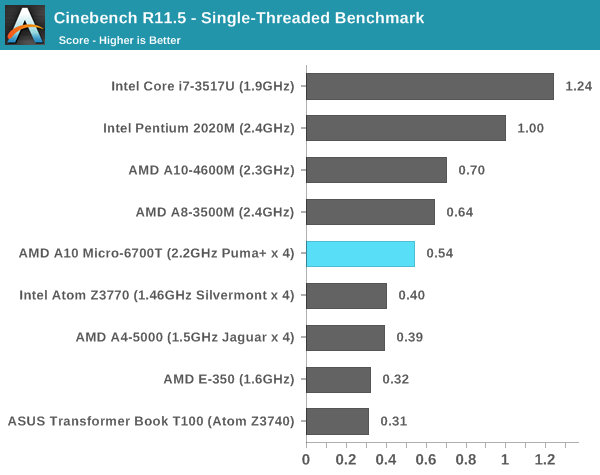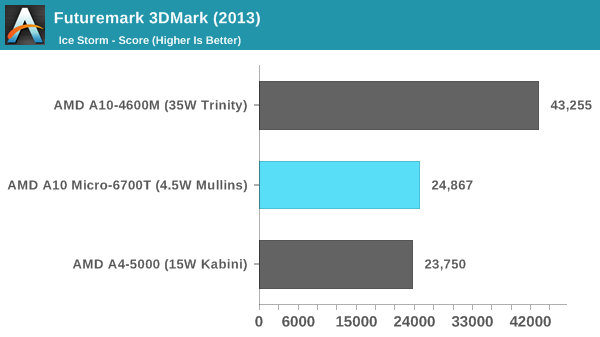AMD has announced its 3rd-generation Mainstream and Low Power Mobile Accelerated Processing Units (APUs), codenamed codenamed “Beema” and “Mullins,” respectively, featuring four x86 Puma+ CPU, AMD Radeon graphics, and a platform security processor (PSP) with an ARM Cortex-A5 core for ARM TrustZone security. Beema APUs have a TDP between 9W and 15W, whereas Mullins APUs all have less than 5W TDP (2.8W SDP). So I’ll only cover cover Mullins processors in this post, as they may offer an alternative to Intel Bay Trail-T processors.
 There are now 3 more APUs part of AMD’s tablets and 2-in-1 solutions: A10 Micro-6700T, A4 Micro-6400T, and E1 Micro-6200T. They are highlighted in green in the table below, and compared to previous generations:
There are now 3 more APUs part of AMD’s tablets and 2-in-1 solutions: A10 Micro-6700T, A4 Micro-6400T, and E1 Micro-6200T. They are highlighted in green in the table below, and compared to previous generations:
| Model | Radeon Brand | CPU Clock Speed (Max/Base) | CPU Cores on Die | TDP | Total L2 Cache | GPU Clock Speed (Max/Base) | DDR SDRMA Max Memory Speed |
|---|---|---|---|---|---|---|---|
| A10 Micro–6700T | Radeon R6 | 2.2 GHz | 4 | 4.5W | 2MB | 500MHz | DDR3L-1333 |
| A4 Micro–6400T | Radeon R3 | 1.6 GHz | 4 | 4.5W | 2MB | 350MHz | DDR3L-1333 |
| A6–1450 | Radeon HD 8250 | 1.4GHz / 1.0GHz | 4 | 8W | 2MB | 400MHz / 300MHz | DDR3L-1066 |
| A4-1350 | Radeon HD 8210 | 1.0GHz | 4 | 8W | 2MB | 300MHz | DDR3L-1066 |
| A4-1250 | Radeon HD 8210 | 1.0GHz | 2 | 8W | 1MB | 300MHz | DDR3L-1333 |
| A4-1200 | Radeon HD 8180 | 1.0GHz | 2 | 3.9W | 1MB | 225MHz | DDR3L-1066 |
| E1 Micro-6200T | Radeon R2 | 1.4GHz | 2 | 3.95W | 1MB | 300MHz | DDR3L-1066 |
Beside the new Puma+ CPU cores, and AMD R Series GPU, performance and power consumption have been achieved thanks to:
- AMD Enduro technology for a longer battery life;
- AMD Start Now technology for quick boot-up and resume from sleep mode
- AMD Turbo Core technology adding turbo mode when more performance is required.
The company is apparently focusing their efforts ion Windows, and end-users would have to use BlueStacks running on top of Windows for Android support.
Anantech got hold of an 11.6″ tablet reference design (Discovery Tablet) powered by A10 Micro-6700T, and running Windows 8.1. Benchmarks showed most individual tests easily outperforming Intel Atom “Bay Trail” Z3770 quad core processor in terms of CPU performance.

Multi-threaded performance was however similar to Z3770 in Cinebench multi-threaded benchmark. The A10 Micro-6700T powered tablet was also clearly ahead in JavaScript/Web Browser test against platform such as Asus Transformer Book T100 (Intel Atom Z3740) and Apple iPad Air. One oddity was the lower performance of the reference tablet with PCMark7 which tests the overall system performance. Anandtech assumed the disappointing score may be due to other components of the tablet or thermal limits of the tablet.

They could not compare GPU performance against competing platforms, but the latest AMD processor appears to have a decent GPU performance considering the 4.5W TDP Mullins processor can match, and even slightly outperform, AMD’s Kabini AMD-5000 with 15W TDP.
More benchmark results are also available via Hot hardware.
Anandtech did not have to test the power consumption of the device. But using numbers provided by AMD, Anandtech compared the idle power consumption between AMD Mulins (620 mW) and Qualcomm Snapdragon (320mW), and it’s clear although AMD has made tremendous improvement in terms of power consumption, they can’t quite match ARM, at least when it comes to idle power consumption, at this point. Later processors will implement an integrated voltage regulator, per part adaptive voltage, and more to lower further power consumption.

Jean-Luc started CNX Software in 2010 as a part-time endeavor, before quitting his job as a software engineering manager, and starting to write daily news, and reviews full time later in 2011.
Support CNX Software! Donate via cryptocurrencies, become a Patron on Patreon, or purchase goods on Amazon or Aliexpress




